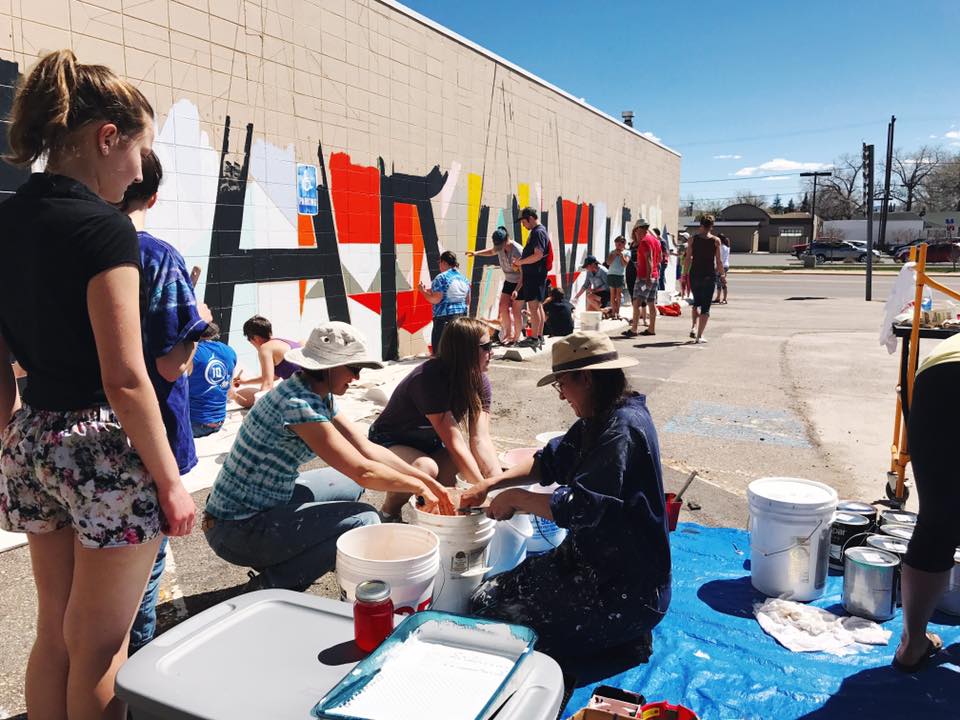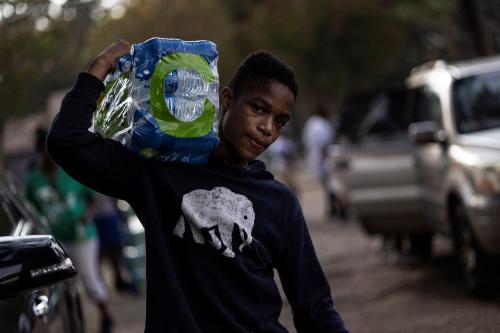This brief is part of a five-part series examining how downtown commercial corridor revitalization can support rural recovery and resilience, and the policy and capacity-building supports needed to enhance and scale these strategies amid the COVID-19 crisis and beyond.
Contents
- I. Introduction
- II. Why robust civic structures matter for rural resilience
- III. Findings: Can downtown revitalization support the development and capacity of community-based organizations, coalitions, and networks to build rural resilience in the months and years to come?
- IV. Conclusion
I. Introduction
The dispersion of COVID-19 has been uneven from the outset, preying upon preexisting fault lines in our nation’s economic, social, and geographic landscape and systematically disadvantaging already vulnerable people and places. Governmental responses have been similarly fragmented and unequal, with federal, state-level, and citywide services and relief structures marked by inconsistency and disparate outcomes by race and place. In these times of uncertain and uneven relief, people and small businesses are increasingly turning to local organizations for relief—seeking support from the community institutions, neighborhood coalitions, and other civic structures that they know and trust.
Over the past several months, much attention has been paid to the importance of community-based actors in promoting recovery in urban areas, focusing on the critical role of community development financial institutions and community banks in supporting minority- and women-owned businesses, as well as the role of mutual aid groups in serving disproportionately impacted residents in low-income neighborhoods. But we know less about how community-based organizations and coalitions are stepping up in rural areas, where residents and small businesses face similar inequities in economic and community well-being and structural barriers in accessing relief. (It is imperative to note that despite often being portrayed as racially homogenous, rural America is home to sizeable Black, Latino or Hispanic, and Native American populations, as well as a growing number of minority-owned and -led small businesses that face compounding systemic injustices amid the COVID-19 crisis.)
To this end, this brief takes a deep look at the local actors and organizations working to promote recovery and resilience in rural America. As part of a research series on downtown revitalization in rural communities across the United States, we focus specifically on how Main Street organizations and other place governance entities are not only providing recovery relief to rural residents and small businesses, but also how they are supporting the development and capacity of other community-based organizations, coalitions, and networks that are needed to build resilience in the months and years to come. Drawing from on-the-ground research in three rural communities at the outset of the COVID-19 outbreak in the United States, we highlight key lessons learned for other rural communities and point to the policy and capacity-building supports needed to sustain, improve, and scale these locally led efforts amid the COVID-19 recession and beyond.
|
Methods: How we examined civic structures in rural America
The Brookings Bass Center for Transformative Placemaking and the National Main Street Center conducted on-the-ground research in Emporia, Kan., Wheeling, W.Va., and Laramie, Wyo. It consisted of in-depth interviews with 62 residents, business owners, and other key stakeholders, as well as four supplemental focus groups with residents and entrepreneurs between February and March 2020. For a full description of our mixed-methods and approach, see “Why Main Streets are a key driver of equitable economic recovery in rural America.”
Overall, we examined the effectiveness of downtown revitalization on four key outcomes of community well-being, including economic, built environment, social, and civic outcomes. This brief focuses on the strength of civic infrastructure in rural America. Using the Bass Center’s transformative placemaking framework, we examined the extent to which rural downtown revitalization efforts can foster civic structures that are:
1. Locally organized: Supporting place governance structures that are representative of the community, outcome-oriented, and sustained by funding, expertise, and partnerships 2. Inclusive: Prioritizing the co-creation of initiatives and programming by a wide range of stakeholders, celebrating open and respectful dialogue, and operating with transparency and fairness 3. Networked: Advancing the development of formal networks and organizations within the community while also supporting resident engagement in broader city and regional civic structures |
II. Why robust civic structures matter for rural resilience
As we document throughout this series, residents and small businesses in rural America face systemic barriers related to poverty, outdated infrastructure, economic exclusion, limited resources, and a lack of public and private services. These barriers are magnified for Black, Latino or Hispanic, and Native American rural residents as well as minority-owned and -led small businesses.
For decades, local leaders, community development organizations, Main Street organizations, and other civic institutions have engaged in place-based efforts to address these structural challenges and enhance quality of life and opportunity for residents and small businesses. In rural communities, where access to community development financial institutions (CDFIs) and community development corporations is more limited, local Main Street programs play an especially important role in economic and community development—most notably through efforts to promote vibrant downtown commercial districts that support independently owned businesses; increase tax bases, employment, and public and private investment in the community; and preserve and adapt the historic core of a community.
While the presence of a Main Street organization or similar place governance entity is in itself an indicator of civic capacity (and a critical input for place-based revitalization), to be truly successful, these organizations must also strengthen the civic structures within the community at large to support the growth of and collaboration between organizations, institutions, and networks that connect people with one another, address shared concerns, and solve public problems.
Research points to several strategies rural leaders can employ to strengthen the civic structures within their communities; however, we lack an understanding of whether these are being implemented and garnering success on the ground and, moreover, how they might withstand the COVID-19’s acute economic shock. The strategies include:
- Research suggests that place-based revitalization efforts must be intentional in mitigating the funding and legal structures that prioritize businesses’ needs over residents’ needs by devoting concomitant energy to strengthening the formal and informal local structures that represent communities’ diverse voices and advocate on behalf of residents—sustaining and supporting them through funding, partnerships, and sharing expertise.
- Research suggests that partnerships between community organizations, small businesses, and regional entities can strengthen the capacity of local organizations, as these partnerships help lessen the structural barriers that community-based organizations face in accessing resources and advance a common, cross-sectoral vision for enhancing community capacity at large. A promising example can be seen through the practice of “place-conscious capacity-building” with rural universities, in which universities strategically deploy their resources to enhance community capacity through training programs for residents or applying campus research initiatives to address local needs, for instance.
- Research indicates that locally owned businesses can be important civic structures themselves, as local business owners are financially and socially invested in the community, likely to participate in community organizations and associations, and may be less likely to pull out of communities during economic downturns due to deep community ties. Efforts to increase the number of locally owned small businesses can thus also serve to strengthen civic capacity.
- Finally, research indicates that local leaders must eliminate the barriers underserved residents face in accessing civic structures, which often means rethinking institutionalized systems of governance (e.g., traditional public meetings and hearings) to meet residents where they are (e.g., parks, schools, restaurants, social service providers, and libraries).
The imperative to understanding and enhancing community capacity is more urgent than ever, as the COVID-19 crisis reveals the adaptability and ingenuity of communities’ local civic infrastructure—from grassroots groups to neighborhood associations to formal place governance organizations—while also exposing their financial precarity.
|
A glimpse into Wheeling, Emporia, and Laramie
Strong civic structures are often considered valuable assets in many rural communities. However, barriers to accessing these assets persist across race, class, and gender. Here, we provide a brief description of some of the socioeconomic challenges present in the three study communities, as well as some of the local actors working to mitigate them. (For a more complete description of the study communities, see “Why Main Streets are a key driver of equitable economic recovery in rural America.”)
Wheeling, W.Va.: A former industrial town, Wheeling struggles with depopulation (40% decline since 1970), persistent disparities in poverty rates by race (37% of Black Wheeling residents experience poverty), and more limited broadband connectivity than rural residents overall (28% of households lack internet access). There are also significant gaps in food access and high rental costs relative to income. Wheeling’s Main Street organization is focused on enhancing economic opportunity downtown by leveraging historic assets, increasing housing, and supporting small businesses. It works in partnership with the city, regional entities like RED, nonprofits like Grow Ohio Valley, community associations like Women’s Giving Circle, and social service providers like the YWCA.
Emporia, Kan.: Home to Emporia State University and a Tyson meat-processing plant, Emporia has the highest proportion of Latino or Hispanic residents of the study communities (27% of the population) and the lowest median income ($39,063). Emporia faces significant racial disparities in poverty rates, high-cost rental housing, and major barriers in food access. Emporia’s Main Street organization focuses on similar downtown revitalization strategies: enhancing small business development, adding market rate housing units downtown, offering low-cost incubator spaces, and encouraging community participation in events. It often works in partnership with Emporia State University, Flint Hills Technical College, city and regional stakeholders, and community groups like Hispanics of Today and Tomorrow.
Laramie, Wyo.: With an economy dependent on the University of Wyoming, Laramie is one of the poorest communities per capita in the state. Laramie’s Native American and Latino or Hispanic residents face high poverty rates (66% and 28%, respectively). Laramie residents are housing-cost-burdened (53.1% of renters pay more than 30% of their income in rent) and lack adequate access to healthy foods. Laramie’s Main Street organization has worked to coordinate with city and regional actors to support small business development, implement infrastructure improvements, and increase food access downtown, among other strategies. It often works in coordination with the array of anchor institutions and economic development stakeholders in Laramie, including the University of Wyoming, Laramie County Community College, the Wyoming Business Council, the Laramie Chamber Business Alliance, and other smaller nonprofit and community organizations). |
III. Findings: Can downtown revitalization support the development and capacity of community-based organizations, coalitions, and networks to build rural resilience in the months and years to come?
To understand the role that place-based civic structures (e.g., Main Street organizations and their community-based partners) play in revitalizing rural downtowns—and, in turn, how such revitalization strengthens civic ties—we interviewed 62 small business owners and other key stakeholders and conducted more open-ended focus groups with small businesses and residents. Our research reveals three primary findings about the role Main Street revitalization can play in strengthening communities’ civic infrastructure.
Finding #1: Absent adequate public sector support, Main Street organizations act as a central supportive structure for small business, nurturing a more resilient network of locally owned small businesses downtown.
As we demonstrate in “Rural small businesses need local solutions to survive,” local Main Street organizations implement an array of interventions to support small businesses and entrepreneurs, including direct capital investment, crowdfunding campaigns, skills training, incubator spaces, and formal partnerships with city and regional structures to enhance capacity. But when we dove deeper into the impact these efforts have on small business resilience, we found that their success was not just about the services offered, but rather, the centrality of the Main Street programs’ role as a supportive structure for small businesses in the absence of similar supports from other public and private entities. Across all three communities, stakeholders explained how local Main Street programs stepped in to provide resources and services that the city and other public entities did not or could not. “I don’t associate [the city] with doing a lot of small business development work,” a Wheeling economic development stakeholder told us. “I don’t think it’s an effort to not support small businesses—I just don’t know if that’s how they view themselves.”
This was often due to limited financial resources. When explaining why they stepped up to take on a more multifaceted role, an Emporia Main Street representative told us, “We saw cuts to county resources and have picked up a lot of what used to be government responsibilities, acting as a communication liaison for infrastructure, working on master development agreements, being a clearinghouse for different loans, housing development…We’re pretty varied in what we do.”
A resident in Laramie echoed similar sentiments: “There’s no tax base here…That’s what makes something like Main Street so important for the community.”
Time and time again, residents and small business owners explained how Main Street organizations leveraged their funds and relationships to meet small business needs, often relying on staff and volunteers to come up with creative solutions for long-overdue projects. An Emporia resident illustrated this through the example of downtown beautification efforts: “There was not money allocated to maintain the gardens downtown, so Main Street came up with the idea of having Adopt-a-Garden, and so they invited individuals and organizations to adopt one of the gardens downtown and be responsible for taking care of it. And without that kind of program, things would not have gotten done.”
Overwhelmingly, small business owners described Main Street as their go-to resource for support—a relationship that has only expanded amid COVID-19, as local Main Street organizations rapidly shift their models to assist with disaster relief funding, offer additional funding streams, and engage in intensive direct counseling with small business owners in need. Our national small business survey conducted this August found that rural respondents were much more likely to receive support from a Main Street organization than from a city agency.
Finding #2: Downtown revitalization encourages the development of formal organizations and networks among residents and small businesses, which fosters the community relationships needed to build resilience.
A key aim of any community revitalization effort must be enhancing the capacity of other community-led organizations, from grassroots groups to neighborhood associations to formal clubs. In all three study communities, Main Street organizations made this a critical aspect of their revitalization approach, ultimately supporting the development of new organizations to advance community priorities and nurturing partnerships between these organizations to encourage collaboration.
In Laramie, for instance, the Main Street program helped fund an artist collective to throw arts-based pop-ups and lead a mural project downtown. It then advocated for members of the collective to be part of a new formal public arts coalition. “Laramie Art Party, we’re just an informal collection of artists,” said a representative of the arts coalition. “So, Main Street has been our fiscal sponsor for several projects if there’s a tie-in to downtown and it aligns with Main Street’s mission. We’ve partnered several times, including the pop-up.”
Emporia’s Main Street organization created an intentional partnership with a Latino-led community organization, collaborating to fund Latino- or Hispanic-owned small businesses and sponsor events to welcome Latino or Hispanic residents downtown (see “Rural Main Streets can’t achieve true economic revival without bridging social divides” for more details).
In Wheeling, the Main Street organization’s crowdfunding program inspired one of the town’s civic groups—the Women’s Giving Circle—to pool their resources to fund aspiring women entrepreneurs, ultimately providing them with $5,000 of capital investment. Wheeling’s efforts to increase small business density have also led to the creation of new informal networks among small business owners downtown, which have since become a critical support lifeline during COVID-19. “Organically, there are a lot of businesses supporting each other as well,” a Wheeling stakeholder said. “There’s an area called Market Plaza where those businesses are all very ‘in the know’ with what’s going on with each other, and how they can collaborate…So it’s almost like there’s like identities that are being created amongst different pockets or blocks of downtown.”
Finding #3: More work is needed to move past institutionalized systems of governance and meaningfully engage residents of color and low-income residents in civic life.
Despite their dedication to engaging a diverse collection of residents through existing civic structures, Main Street organizations encountered persistent barriers to inclusion in public meeting and participation processes.
In Emporia, the Main Street organization attempted to reach Latino or Hispanic residents through community partnerships and by hosting engagement activities in public spaces and at events, but still faced barriers in ensuring Latino or Hispanic representation in more formal groups and gatherings. “Just in general, with boards, commissions, visibility at community gatherings, based on the number of Hispanic families that we have, we don’t see enough of those at those kind of opportunities,” an Emporia stakeholder told us. “So we keep on trying to figure out, ‘Who do we put on these boards? Who do we put on these commissions? Where do we host these meetings to attract more of that audience?’ Because we know that’s a demographic that we need to serve, and it’s been a hard one for us to reach out to. But that’s a huge demographic for us to be able to engage in the next 10 years.”
Similar challenges with traditional participatory mechanisms were raised during a focus group we conducted with Wheeling residents. Many focus group participants had never been to a public engagement meeting of any kind, and when we asked why not, they made comments such as: “Who’s getting the invitation to those? How do you have access to one of those places? You have to already know, you have to already be a part of that group.” Focus group participants emphasized that participatory inclusion challenges would be particularly stark for low-income residents and residents of color in the historically disinvested East Wheeling community adjacent to downtown, who are even more disconnected from formal civic structures.
In Laramie, which struggles with high housing costs, stakeholders remarked that the people most impacted by these costs are not at meetings. As one stakeholder explained, “We had a session…during the plan on housing in Laramie, and you had a bunch of people who clearly were not in the lower economic bracket talking about, ‘How do we serve people who can’t afford homes?’ And I said, ‘I feel like a key demographic is missing here, mainly, the people who need those homes.’” Laramie’s Main Street organization strived to mitigate these challenges by conducting direct outreach to residents and business owners, but with a small staff and budget, there were limits to what they could achieve through relationship building.
These challenges with traditional participatory mechanisms are not unique to Main Street communities. But as public engagement processes become even more complicated amid COVID-19, the need to increase outreach to underserved residents is even more dire. It will be necessary to expand the neighborhood-level engagement work that place-based organizations like Main Streets are conducting, bringing it to more communities that typically lack the resources to support this kind of dedicated governance.
IV. Conclusion
Our nation’s Main Streets cannot recover from the COVID-19 crisis alone. They rely on the dedication of local organizations, intermediaries, and associations that have long worked with residents and businesses to co-create vibrant, inclusive places of opportunity.
Throughout this research series, we demonstrate how local Main Street organizations—in partnership with community leaders, public officials, and other nonprofit entities—are championing holistic strategies to build rural resilience in the months and years to come. This includes ensuring the survival of small businesses, advocating for built environment and quality-of-life improvements across multiple levels of governance, strengthening social ties between neighbors, and nurturing new civic structures to advance community priorities. To truly recover as a nation, we must invest in the hyperlocal support systems that are already working to bring growth and equity to rural areas, and embrace new ways of thinking that allow rural community leaders to tackle place-based inequities and foster inclusive, vibrant, and connected rural places in the long term.
The authors thank Joanne Kim and Evan Farrar for their research assistance.
The Brookings Institution is committed to quality, independence, and impact.
We are supported by a diverse array of funders. In line with our values and policies, each Brookings publication represents the sole views of its author(s).





